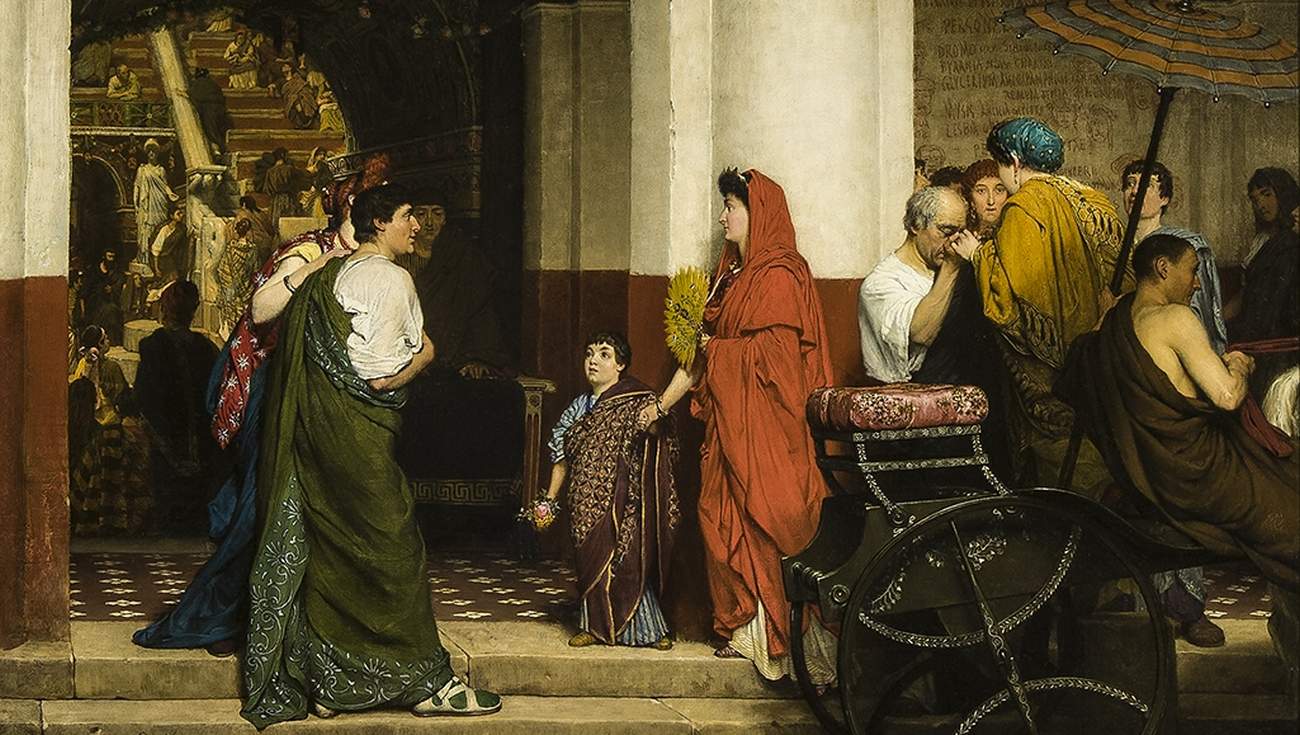Symposium – Alma-Tadema: Antiquity at Home and on Screen (2017)
Leighton House Museum, Paul Mellon Centre, Birkbeck Institute for the Moving Image, 19-21 October 2017

‘Alma-Tadema: Antiquity at Home and on Screen’ was a symposium held from Thursday 19 to Saturday 21 October 2017, in conjunction with the exhibition Alma-Tadema: At Home in Antiquity during the final stop of its international tour, at Leighton House Museum in London. It was organised by Professor Elizabeth Prettejohn (University of York) and Dr Peter Trippi (Editor-in-chief of Fine Art Connoisseur), both also co-curators of the exhibition, with Dr Sarah Victoria Turner (Deputy Director for Research, Paul Mellon Centre), Professor Maria Wyke (UCL) and Professor Ian Christie (Birkbeck); and it brought together scholars and students from a wide range of disciplines to explore the artist Lawrence Alma-Tadema's work and influence.
The symposium began with a Scholars' Workshop, by invitation only, on Thursday 19 October. In the evening, attendees to both the Friday and Saturday sessions were invited to attend a private viewing of the exhibition.

Anna Alma-Tadema, 'Sir Lawrence Alma-Tadema's Library in Townshend House, London', 1884; watercolor, gouache, pen and brown and black ink, graphite on white paper; Thaw Collection, 2007-27-72, collection.cooperhewitt.org/objects/18708237/; Cooper Hewitt, Smithsonian Design Museum
The Paul Mellon Centre hosted the symposium on Friday 20th. Professor Prettejohn, Dr Trippi and Dr Turner gave the welcome and introduction.
Speakers were:
Plenary
Chair: Liz Prettejohn
Christopher Reed (Pennsylvania State University): ‘Living in the Past; Or, What Do We Want From Artists’ Houses?’
Panel 1: Artists’ Houses in Britain
Chair: Morna O’Neill (Wake Forest University, US)
Charlotte Gere (Independent Scholar): ‘An Alma-Tadema House’
Caroline Dakers, (Central Saint Martins, University of the Arts London): ‘The influence of Alma Tadema is everywhere, he is our Master’ (Henry Woods, RA, 21 April 1887). Exploring the ‘master mind’ of Alma Tadema.
Shelley Hales (University of Bristol): ‘Re-staging the Roman Home’
Panel 2: International Contexts
Chair: MaryAnne Stevens (independent art historian and curator)
Jan Dirk Baetens (Radboud University, Nijmegen, the Netherlands): ‘The (Time) Traveller's House: The Hôtel Leys and the Casa Tadema’
Stephanie Moser (University of Southampton): ‘Archaeology, Egyptology and a Passion for Domestic Things’
Nicholas Tromans (Watts Gallery): ‘From Studio-House to Museum: The Artist's Studio Museum Network’
Plenary:
Chair: Peter Trippi (Editor-in-chief of Fine Art Connoisseur)
Mary Roberts (University of Sydney): ‘The Resistant Materiality of William De Morgan’s “Arab Hall”’
Paper:
Chair: Sarah Turner (Paul Mellon Centre)
Peter Trippi (Editor-in-chief, Fine Art Connoisseur): ‘From Galleries and Printsellers to Theatres and Cinemas: Transmitting Alma-Tadema 1893–1913’
View the Introduction by Elizabeth Prettejohn and Peter Trippi below:
Other presentations from this first full day can be viewed on the Paul Mellon website.

Still from silent film 'Gli ultimi giorni di Pompei' ('The Last Days of Pompeii'), 1908, directed by Arturo Ambrosio and Luigi Maggi (public domain)
The second full day, Saturday 21 October, was held at Birkbeck Institute for the Moving Image. Whilst the focus on the Friday was on the homes and domestic display spaces of artists, with particular reference to Alma-Tadema, this day's proceedings put the spotlight on Alma Tadema's influence on the performing arts: theatre, tableaux vivants, and especially film.
Maria Wyke and Ian Christie gave the Welcome.
Speakers were:
Panel 1: Envisioning Antiquity at the Turn of the Century (precinematic)
Chair: Pantelis Michelakis (University of Bristol)
David Mayer (University of Manchester): 'Lawrence Alma-Tadema in the Theatre, 1881-1906'
Fiona Macintosh (University of Oxford): 'Dance, Decadence and Cosmopolitan Bodies in Early Twentieth-Century Britain'
Valentine Robert (University of Lausanne): 'In Between the Frame, the Stage, and the Courtroom: Alma-Tadema's Tableaux Vivants'
Panel 2: Envisioning Antiquity in Silent Cinema
Chair: Pantelis Michelakis (University of Bristol)
Céline Gailleurd (Université Paris 8): ‘From the representation of intimacy to that of the orgy: the underground influence of Alma-Tadema through Italian silent films in the 1910s’
Maria Wyke (University College London): ‘Contra Tadema: Femininity, the Collective, and the Nation in Silent Cinema’s Pompeii’
Panel 3: Envisioning Antiquity from Silent Cinema to the 21st Century
Chair: Pantelis Michelakis (University of Bristol)
Michael Williams (University of Southampton): ‘“To Live and Breathe with Light”: Star Bodies, Ancient Spaces and the Influence of Alma-Tadema’
Ivo Blom (Vrije Universiteit, Amsterdam): ‘Art and Art Decoration: Alma-Tadema and Set Design from Guazzoni to Ridley Scott’
Ian Christie (Birkbeck, University of London): ‘After Tadema: Visions of Antiquity in British Cinema'
The presentations were followed by a film screening introduced by Ivo Blom: four short, silent films made between 1908 and 1911 from EYE's Desmet Collection, accompanied by live piano.
The symposium concluded with a Roundtable Discussion chaired by Maria Wyke, Ian Christie and Elizabeth Prettejohn.
The symposium was supported by the Paul Mellon Centre, the A. G.Leventis Foundation and the University of York.
Ivo Blom wrote about the symposium in his blog post about the Alma-Tadema project.
Main image: Sir Lawrence Alma-Tadema, Entrance of the Theatre (also known as Entrance to a Roman Theatre; detail), 1866, oil on canvas, 67.4 x 96.0 cm; 109.5 x 138.0 cm (frame), Collection Fries Museum, Leeuwarden – acquisition supported by the Rembrandt Foundation (in part through its Saskia Fund and its Van Rijn Fund), the BankGiro Lottery, the Mondriaan Fund, the Wassenbergh-Clarijs-Fontein Foundation and the Friends of the Museum of Friesland. Photo © Martin Rijpstra
